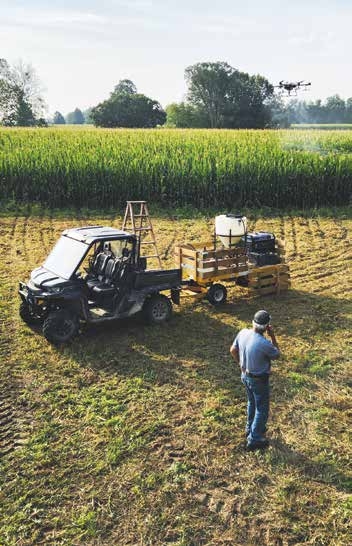11.Federal Aviation Administration Regulations
RESOURCES - PUBLICATIONS
The Evolution of Spray Drones, Their Capabilities and Challenges for Pesticide Applications
11.Federal Aviation Administration Regulations
The United States Congress assigned the federal regulatory oversight of drones to the Federal Aviation Administration (FAA). With commercial use of spray drones being a recent phenomenon in the United States, FAA regulations and policies outlining who can pilot drones and under what conditions they may operate them are still in flux. Note that the following descriptions about current drone regulations will surely change as policies evolve.
Therefore, we advise you to check the FAA website (https://www.faa.gov/) often for the most current regulations concerning drone use. Additionally, when drone operation requirements conflict with FAA rules, for which no authorization or waiver authority is available, the Secretary of Transportation has exemptive authority to grant conditional exemptions based on petitioners’ requests.
The FAA regulations drone users must follow depends largely on three factors:
- Whether the drone is flown for recreational purposes or commercial uses (all spray drones will be classified as commercial use)
- Overall weight of the drone
- Commercial use of the drone — that is, applying agricultural products versus capturing images
Recreational Versus Commercial
Although the FAA has a clear definition of recreational, or hobby, drones, the interpretation of the rules can encompass purposes that are not well defined, especially in the world of agriculture. If you buy a drone to fly over your farm for enjoyment, then you would assume you are flying for recreational uses. But what if you see something in your crop field and you take a closer look and find out that you need to control some weeds? Or, what if you see a nutrient deficiency that you go out and remedy?
Do these still count as recreational since you made business decisions?
Our interpretation is that drones used for recreational purposes includes flying drones for fun, using them in competitive races, or taking pretty photographs. Conversely, drones that provide any value to a business or farm is designated as commercial.
For instance, a drone flying a field sends back images that suggest a pesticide applicator in a ground rig had not cleaned out the booms properly before spraying the field. The drone provided the farm a commercial benefit. Taking photographs with your drone that you use on advertising brochures or websites would also be considered commercial use. As with most cases, if you are unsure if the use is recreational or commercial, it is best to play it safe and follow the rules of a commercial drone pilot.
 Although taking photographs of the top of a forest or watching a combine work a field could be viewed as recreational, you should always read the information given by FAA on what is considered “recreational use of a drone.”
Although taking photographs of the top of a forest or watching a combine work a field could be viewed as recreational, you should always read the information given by FAA on what is considered “recreational use of a drone.”  Using a drone to measure heat loss or to see a pesticide tank contamination complaint would be considered commercial use of the drone.
Using a drone to measure heat loss or to see a pesticide tank contamination complaint would be considered commercial use of the drone.  Operators are using both photographs to make decisions that affect the revenue or profits for a business or farm and would be classified as commercial uses.
Operators are using both photographs to make decisions that affect the revenue or profits for a business or farm and would be classified as commercial uses. Drone Weight Divided into Three Categories
Some FAA drone regulations apply to all drones regardless of their size, while other regulations are targeted to certain weight classes.
The FAA currently divides drones into three weight categories:
- Less than or equal to 0.55 pounds This is an example of a drone that weighs less than 0.55 pounds and is exempt from many FAA regulations.
- Greater than 0.55 and less than 55 pounds
- Equal to or greater than 55 pounds
A drone’s total weight is calculated by adding the weight of the platform, all onboard accessories, and the payload it carries.
Drones that weigh less than 0.55 pounds have limited commercial uses. These lightweight drones do not require federal registration and can be flown without being a certified pilot if they are used for recreational purposes.
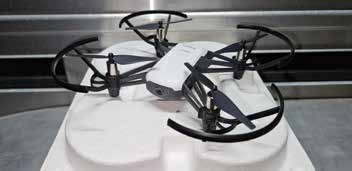 This is an example of a drone that weighs less than 0.55 pounds and is exempt from many FAA regulations.
This is an example of a drone that weighs less than 0.55 pounds and is exempt from many FAA regulations. 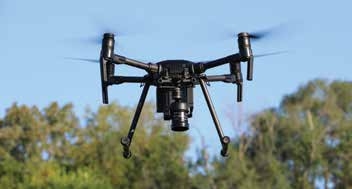 This drone weighs around 11 pounds.
This drone weighs around 11 pounds. DRONE FACT
If you are unsure whether you are using your drone for recreational or commercial purposes, it is best to get a commercial license and follow the commercial drone operation rules. If you are using it for agriculture, your drone is mostly likely considered commercial.
All drones that weigh more than 0.55 pounds and used commercially must comply with a set of baseline FAA regulations that deal with pilot certification and drone registration as well as product applications. Requirements include:
Remote Pilot Certification for Commercial Drones
The FAA requires certification for pilots to operate aircraft remotely (operators not in cockpits of planes) for commercial purposes. The multiple-choice exam, called the Airman Knowledge Test (or Part 107), is taken at an FAA approved testing site under review of a proctor.
You will need to visit the Integrated Airman Certification and Rating Application (IACRA) website to create a personal identification number. This number, known as the FAA tracking number (FIN), is unique to you and is used to complete your airman certification application. In addition, you will need to provide proof of identity and current address at the time of testing.
Once you receive notice that you have passed the test, you will need to complete FAA Form 8710-13. Bring the completed 8710-13, a photo ID, and online course completion certificate to an official site to validate your identity (see Step 5 at the following website: https://www.faa.gov/uas/commercial_operators/become_a_drone_pilot).
Alternatively, you can also fill out this form online, and you will receive your certificate in the mail. At that time, you will receive a temporary airman certificate. In several weeks, the FAA will send you a permanent remote pilot certificate. Remote pilot certifications are valid for two years. At the end of each two-year period, you can renew your remote pilot certification by retesting or by completing a free online continuing education course known as FAA Drone Pilot Recurrent Training for Part 107 Small Unmanned Aircraft Systems Course.
After 24 months, you will need to have a recurrent certificate of achievement with you in addition to your Remote Pilot Certificate whenever you fly. You can complete this additional training online using a computer at your business or home. Continuing education is an easier way of keeping apprised of changing FAA regulations, polices, procedures, and interpretations than the retesting option.
Pesticide Certification Through Pesticide Regulatory Agencies
All states require individuals applying pesticides through spray drones to be certified.
Some states may require a basic core test and possibly additional tests. This includes both commercial businesses and private applicators (farmers).
The National Pesticide Information Center provides a state list of pesticide regulatory agencies and contact information at npic.orst.edu/reg/state_ agencies.html.
Register the Drone with the FAA
All drones greater than 0.55 pounds must be registered with the FAA. When you register a drone, the FAA will assign a unique number specific to that aircraft. This is like a vehicle registration. The FAA also collects information about who owns the drone and their address. The FAA number must be attached and outwardly visible on the drone. If a drone goes down or someone gets hurt, the number carried on the drone can help identify the pilot or owner of the aircraft.
 This table shows a comprehensive list of drones registered to one of the authors.
This table shows a comprehensive list of drones registered to one of the authors.
The current FAA registration process depends on the weight of the drone and its intended use. Drones weighing less than 55 pounds can be registered online in a few minutes. A drone that weighs 55 pounds or more requires a notary to validate the purchase of the drone and that the purchaser is the one registering the aircraft.
The letter designation that precedes the FAA assigned registration number differs somewhat between drones that weigh more and or less than 55 pounds. A drone that weighs 55 pounds or more will be designated with the letter N, which is similar to manned aircraft registration. Drones that weigh less than 55 pounds will designated with the letters FA. The image on the previous page shows the pilot has four drones that fell in the 0.55-to-55-pound category.
Commercially registered drones that weigh less than 55 pounds must be renewed every three years at a cost of $5. Drones that weigh 55 pounds or greater must be renewed every seven years - like manned aircraft. The number assigned to a drone remains the same throughout repeated renewals.
Can you identify which one of these two drones weighs more than
55 pounds or less than 55 pounds? Clue: check the registration
number.

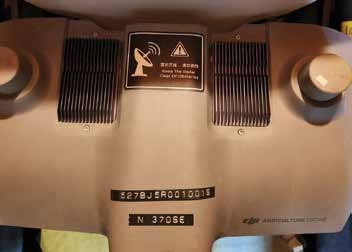
FAA RemoteID Requirements
As of 2022, all drone manufacturers are required to have a built-in RemoteID that broadcasts the ID of the drone with its location and pilot’s location. For drones manufactured before September 16, 2022, without RemoteID hardware, the drone must be retrofit with a RemoteID module to fly in an FAA Recognized Identification Area (FRIA).
The RemoteID signal can be accessed by the public using applications like DroneTag or Drone Scanner. However, the drone owner’s name and contact information can only be obtained by the FAA or law enforcement as a means of protecting the pilot’s privacy.
Altitude Flown Depends on Airspace Restrictions
A drone may not fly more than 400 feet above the ground without an altitude waiver. Most spray drones fly up to a maximum of 50 feet. This includes 15 to 20 feet during application and 40 to 50 feet during takeoff and bringing it back to land.
DRONE FACT
Part 107 allows drones to fly up to 400 feet, but spray drone operations are limited to 200 feet. However, spray drones routinely stay within 10-30 feet of the ground or crop canopy.
With crewed aircraft (the pilot is onboard) flying no lower than 500 feet is a requirement. This ideally provides a 100-foot buffer between drones remotely operated and other aircraft with the pilots onboard.
There are limitations when working in and around an airport in an area known as controlled airspace. Air Traffic Control manages controlled airspace. Flying in controlled airspace is more restrictive and requires clearance before flying in. Rarely are drones allowed to fly higher than 400 feet in controlled airspace without additional authorization.
Within each airport-controlled airspace at surface level, the FAA has established a set of grids to describe the maximum altitude a drone may be flown with prior authorization. It starts at 400 feet when entering the airport-controlled air space, but the maximum altitude is lowered as the drone nears the airport and runways.
The FAA requires pilots flying within controlled airspace to get authorization for operating within that airspace. Pilots flying under Part 107 rules may request immediate authorization to fly in controlled airspace from a Low Altitude Authorization and Notification Capability (LAANC) service supplier. More information about LAANC is available from the FAA: https://www.faa.gov/uas/programs_partnerships.
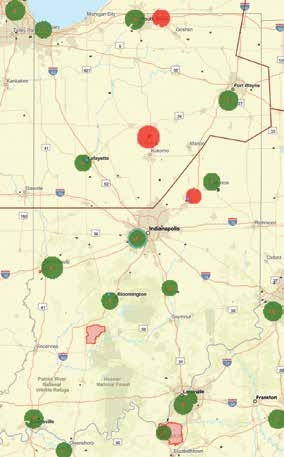 This image shows some of the airport-controlled airspace in Indiana from the FAA website faa.maps. arcgis.com. Green squares represent authorization can be obtained by a LAANC service supplier, while the areas outlined in red require using the FAA DroneZone website.
This image shows some of the airport-controlled airspace in Indiana from the FAA website faa.maps. arcgis.com. Green squares represent authorization can be obtained by a LAANC service supplier, while the areas outlined in red require using the FAA DroneZone website. 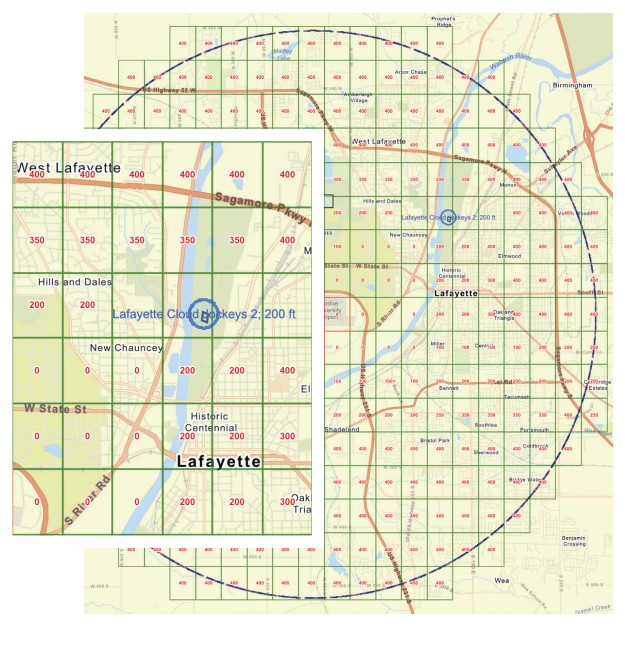 By clicking on the airport that you will be working around, the FAA website (faa.maps.arcgis.com) provides this level of detail. This is the controlled airspace for the Purdue University Airport in West Lafayette, Indiana.
By clicking on the airport that you will be working around, the FAA website (faa.maps.arcgis.com) provides this level of detail. This is the controlled airspace for the Purdue University Airport in West Lafayette, Indiana. When a smartphone places a marker pin for the pilot’s location in a LAANC application, the FAA reviewer will know the pilot’s exact location. Some drone software is integrated with LAANC as well. This service can be used to quickly preapprove your flight plan from your controller or smart phone without any advanced notice in airspace that may have low-altitude flight restrictions. If the operation is in a Zero Altitude grid or a higher altitude is needed than provided in the grid, you may request an Airspace Authorization through the FAA DroneZone website: faadronezone-access.faa.gov.
Using the altitude assigned for your location within that grid, the reviewer will check the flight altitude provided to them on the waiver application. If you fly at or below the maximum allowed altitude within that grid, it generally means they will quickly approve your flight plan. The approval is sent to you via text or email and serves as documentation that the flight was preapproved.
The FAA requires pilots flying within controlled airspace to get authorization for operating within that airspace. You can obtain this authorization in a short time by using a smartphone and following guidelines provided by the FAA. These examples show what the process looks like on a smartphone when you ask approval through the LAANC request.
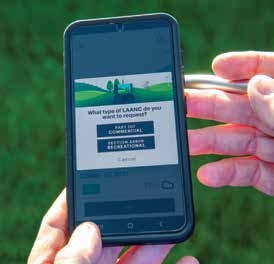 Applying for approval to fly in restricted air space.
Applying for approval to fly in restricted air space. 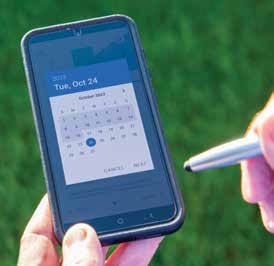 Selecting date and time for flight approval.
Selecting date and time for flight approval. 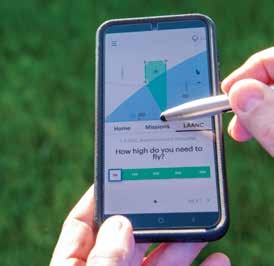 Selecting the area within restricted airspace we are seeking approval to fly.
Selecting the area within restricted airspace we are seeking approval to fly. 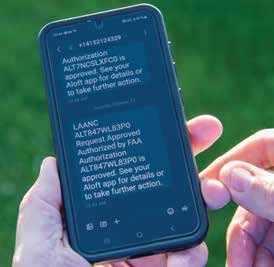 FAA approval to fly
FAA approval to fly The airspace around most military installations is either restricted or prohibited. Restricted airspace includes areas where drones may operate but are subject to restrictions when determined necessary to confine or segregate activities considered hazardous to nonparticipating aircraft. Prohibited means that a drone cannot fly within the designated area — for example, members of the public are prohibited from making flights around the White House.
Knowing whether you are near or in a restricted or prohibited airspace is important before you fly a drone. You can use an FAA application called B4UFLY (https://www.faa.gov/uas/getting_started/b4ufly) to check which airspace you are currently in and whether you need any waiver or are not allowed to fly at all. Failure to comply with airspace restrictions can create significant regulatory enforcement actions by FAA investigators.
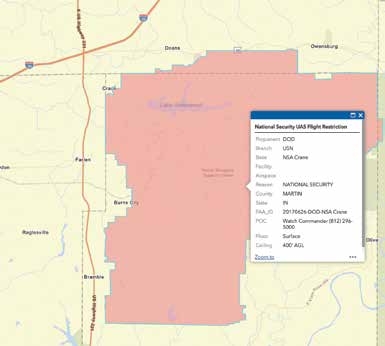
The Crane Naval Base in southern Indiana is listed as prohibited airspace on the Federal Aviation Administration website faa.maps.arcgis.com. Prohibited airspaces do not have grids, which indicates drones and other aircraft are not allowed within the shaded borders.
Pilots Required to See 3 Miles from Their Locations
Under Part 107, a drone can be flown if aerial visibility is at least 3 statute miles, 500 feet below clouds, and 2,000 feet laterally. This ensures that drone pilots can easily see manned aircraft and take evasive actions in case aerial applicators are in proximity of drone operators. Waivers or exemptions are required when pilots want to operate drones when visibility is less than 3 statute miles. Drone pilots should always yield to crewed aircraft in the case they are operating in the same vicinity.
Night Flying Allowed with Anti-Collision Lights
Pilots can fly their drones at night if the aircraft are equipped with anti-collision lights that can be seen from 3 statute miles away, and they flash at a sufficient rate to prevent collision. No waiver is required. However, we do not recommend applying pesticides at night regardless because of concerns about temperature inversions and, often, reduced pesticide activity.
May Not Carry Hazardous Materials
Agricultural products are considered hazardous materials by FAA definitions. At the time of this publication, if the operator wants to use a drone to apply pesticides, fertilizers, or other ag products deemed hazardous by FAA definitions, they must petition the FAA to issue exemptions from certain rules that govern the use of drones.
This includes carrying hazardous materials in spray tanks and for drones that weigh more than 55 pounds. The listed rules of Part 107 on the following pages are not a comprehensive list, but only a small subset of rules that are most applicable to using spray drones. You can find a full list and description of the Part 107 rules you must follow when operating a commercial drone on the FAA’s website.
Applying Agricultural Products from a Drone
Any drone that weighs less than 55 pounds that is used to dispense dry or liquid pesticides (referred to as economic poisons in FAA statutes), plant nutrients, and other products to agricultural, horticultural, and forest areas are subject to rules under CFR 14 Part 137 and Part 107. To legally operate under Part 137, an organization must first obtain a Part 137 operating certificate. Part 137 provides FAA clear authority to provide oversight of aerially applied products. Remember that pesticides applied with drones are regulated by both the EPA and FAA.
Since drones that weigh less than 55 pounds are operated under Part 107 rules, and agricultural operations operate under Part 137, pilots or operators must comply with both 107 and 137. However, as previously stated there are certain rules that spray drones cannot meet, such as the rule outlined under Part 107.36 Carriage of Hazardous Material. Since spray drones and spray drone pilots cannot abide by all the rules outlined in Part 107 and Part 137, pilots or organizations must ask the FAA to be exempt from certain rules.
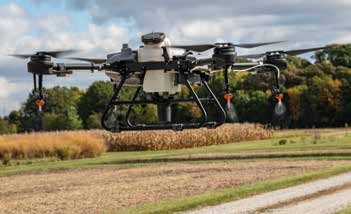
Fully loaded, this drone can weigh as much as 75 pounds.
‘Waiver,’ ‘Authorization,’ and ‘Exemption’ Are Different Terms
When flying under Part 107 rules, there are certain actions that are not allowed, but may be waived. Pilots or operators may apply for waivers and explain what their operations are, what safety precautions they are taking, and what kind of training will be required for remote crew members. An application for authorization is similar to a waiver but involves access to controlled airspace that the LAANC does not grant immediately. The FAA reviews the proposed wavier or authorization and will accept or deny the application within 30 to 90 days. An exemption on the other hand, is required to perform an operation that is strictly prohibited or “unwaiverable” under the current FAA rules.
The first step to obtain a Part 137 operating certificate is to petition for exemption from certain rules that cannot be abided. A list of rules that the organization or operator needs to request to be exempt for less than 55-pound drones include:
- Part 107.36 Carriage of Hazardous Material
- Part 137.19(c) Certification Requirements, Commercial Operator — Pilots
- Part 137.19(d) Certification Requirements — Aircraft
- Part 137.19(e)(2)(ii) Certification Requirements; Knowledge and Skill Tests; Skills; Approaches to the Working Area
- Part 137.19(e)(2)(iii) Certification Requirements; Knowledge and Skill Tests; Skills; Flare-outs
- Part 137.19(e)(2)(v) Certification Requirements; Knowledge and Skill Tests; Skills; Pull-ups and Turnarounds
- Part 137.31(a) Aircraft Requirements; Certification Requirements
- Part 137.31(b) Shoulder Harnesses
- Part 137.33(a) Carrying of Certificate; Certificate Carried on the Aircraft
- Part 137.33(b) Registration and Airworthiness Certificates Available
- Part 137.41(c) Personnel; Pilot in Command; Demonstration of Knowledge and Skills; Commercial Certificate
- Part 137.42 Fastening of Safety Belts and Shoulder Harnesses
For the FAA to approve an exemption, the petitioners must explain how they will maintain a comparable level of safety that the rule creates. The exemption process can be challenging and confusing. Some organizations and operators defer to a legal authority to write the exemption for them, or, in some cases, the drone manufacturer or sales company may assist operators in submitting exemption requests.
What Regulations Am I Following?
Part 137 regulations cover all spray drones, regardless of weight. Part 107 regulations govern all drones less than 55 pounds. Parts 61 and 91 regulations apply to all drones that exceed 55 pounds.
Any pilot who flies a spray drone (regardless of weight) must have a Part 107 pilot’s license. To alleviate the manned pilot license required for Part 61, FAA regulations allow the Part 107 pilot’s license to serve as a substitute.
Notes from the Field
A drone operator indicated:
“There are many lawyers who help with exemption filings. It is a very common practice and has become quite streamlined. What used to take six months is now flowing through in six weeks.”
Part 107 only applies to drones that weigh less than 55 pounds, so spray drones that weigh 55 pounds or more require exemption from 14 CFR Parts 61, 91, and 137. Parts 61 and 91 take the place of Part 107, since drones that weigh 55 pounds or more are not “small” drones, so they are covered under rules more like manned aircraft (for example, aerial applicators).
A list of rules that organizations must ask to be exempt from when flying drones that weigh 55 pounds or more include:
- Part 61.3(a)(1)(i) Requirement for Certificates, Ratings, and Authorizations
- Part 91.7(a) Civil Aircraft Airworthiness
- Part 91.119(c) Minimum Safe Altitudes: General
- Part 91.121 Altimeter Settings
- Part 91.151(b) Fuel Requirements for Flight in VFR Conditions
- Part 91.405(a) Maintenance Required
- Part 91.407(a)(1) Operation after Maintenance, Preventive Maintenance, Rebuilding, or Alteration
- Part 91.409(a)(1) Inspections
- Part 91.409(a)(2) Inspections
- Part 91.417(a) Maintenance Records
- Part 91.417(b) Maintenance Records
- Part 137.19(c) Certification Requirements, Commercial Operator — Pilots
- Part 137.19(d) Certification Requirements — Aircraft
- Part 137.19(e)(2)(ii) Certification Requirements; Knowledge and Skill Tests; Skills; Approaches to the Working Area
- Part 137.19(e)(2)(iii) Certification Requirements; Knowledge and Skill Tests; Skills; Flare-outs
- Part 137.19(e)(2)(v) Certification Requirements; Knowledge and Skill Tests; Skills; Pull-ups and Turnarounds
- Part 137.31(a) Aircraft Requirements; Certification Requirements
- Part 137.31(b) Shoulder Harnesses
- Part 137.33(a) Carrying of Certificate; Certificate Carried on the Aircraft
- Part 137.33(b) Registration and Airworthiness Certificates Available
- Part 137.41(c) Personnel; Pilot in Command; Demonstration of Knowledge and Skills; Commercial Certificate
- Part 137.42 Fastening of Safety Belts and Shoulder Harnesses
To see an example of an exemption that was written to allow Purdue University drone pilots to operate spray drones, visit regulations.gov, and type in “Purdue spray drone” in the search bar. You can also search specific drone manufacturers and drone model numbers or company names to find exemptions written for each particular case.
Once you submit the exemption, the FAA will approve your exemption petition, decline your petition request, or ask for more information. This process may take many months to complete and can be the most time-consuming part of obtaining a Part 137 operating certificate.
If the FAA approves the exemption, they will send a document that outlines the conditions and limitations in which you must operate to comply with the wavier. The document also will explain when the exemption will expire and when it will have to be amended to remain current.
Once you secure the proper exemptions, you may apply for your operating certificate by filling out form 8710-3 and sending it and the exemption to the FAA authority over 137 drone certifications (UA137Certificates@faa.gov). Once the FAA processes the request, a knowledge and skills test can be self-administered where previously a group from your FAA Flight Standards District Office (FSDO) would have administered the exam. This streamlined application process has greatly increased the speed in which operating certificates are processed and distributed.
Once you have satisfactorily completed the certification requirements, you will receive an operating certificate that designates the chief supervisor of the operation and any exemptions that the organization is operating under. The chief supervisor is the person who self-administered the exam and will be in charge of the Part 137 operations for your organization. Once you identify a chief supervisor, that individual will oversee the pilots who operate within your organization and will have to ensure compliance with FAA rules and regulations.
